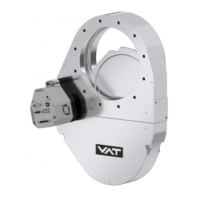What could cause a VAT 653 to fail to find the encoder index pulse?
- NNancy MillerAug 27, 2025
The VAT Control Unit might fail to find the encoder index pulse due to encoder failure or O-Ring sticking.

What could cause a VAT 653 to fail to find the encoder index pulse?
The VAT Control Unit might fail to find the encoder index pulse due to encoder failure or O-Ring sticking.
What to do if the VAT Control Unit shows 'No valve connected'?
If the VAT Control Unit displays a 'No valve connected' message, connect the valve controller to the valve.
What to do if the VAT 653 initialization of motion controller failed?
If the motion controller initialization fails, it might be due to a wrong motion controller firmware version. Update the motion controller firmware to resolve this issue.
What should I do if the VAT 653 initialization of interface module failed?
If the interface module fails to initialize, it could be due to the valve firmware not supporting the interface type, or a wrong interface firmware version. In such cases, you should update the valve firmware or update the interface firmware accordingly.
| Category | Control Unit |
|---|---|
| Input Voltage | 24 VDC |
| Operating Temperature | -20°C to +60°C |
| Protection Class | IP20 |
| Weight | 200 g |
Details the methods for identifying the product via fabrication and order numbers.
Specifies the intended applications and limitations for the throttling pendulum valve.
Lists and defines abbreviations used throughout the manual for clarity.
Lists other relevant documents for comprehensive system information.
Highlights the meaning of symbols indicating critical information for attention.
Provides detailed specifications for the control unit and valve unit.
Emphasizes the importance of reading and understanding safety information before performing work.
Defines danger levels and associated symbols for hazard identification.
Specifies the necessary qualifications for personnel handling the equipment to ensure safety.
Lists safety labels, their part numbers, and locations on the valve for hazard awareness.
Illustrates the physical components of the valve and provides a labelled diagram.
Explains the operational principle of the valve, including throttling and isolation mechanisms.
Provides an overview of the pressure control system and its functional components.
Provides instructions and precautions for safely unpacking the valve components.
Details critical safety warnings and considerations for installing the valve into the vacuum system.
Covers essential safety notices and procedures for making electrical connections to the valve.
Outlines the mandatory setup steps required for enabling pressure control.
Explains how to configure pressure and position scalers for defining units and ranges.
Details basic valve configuration, including default positions and options for power/network failure.
Covers RS232 interface configuration settings, including baud rate, data bits, and parity.
Explains the importance of proper sensor configuration for accurate pressure calculations.
Describes the valve's design for downstream pressure control, supporting local/remote operation.
Explains how to perform remote operation using the RS232 interface and software.
Details how to operate the valve locally using a computer via the service port and software.
Provides instructions for closing the valve via local or remote operation.
Provides instructions for opening the valve via local or remote operation.
Explains how the valve position is directly controlled according to the position setpoint.
Details the setup and tuning procedures for pressure control using the PID controller.
Describes the 4-digit display on the controller and the information it shows.
Details the valve's reaction to power failure, with and without the Power Failure Option.
Explains how error numbers and codes are displayed on the controller.
Details the structure of error numbers, defining component, mode, and error type.
Provides a table mapping error codes to their descriptions and recommended solutions.
Discusses maintenance requirements and factors influencing frequency, advising contact with VAT.
Outlines two main maintenance procedures: seal replacement and valve cleaning.
Provides detailed steps and required tools for replacing isolation seals and cleaning the valve.
Details the procedure and tools required for replacing actuator shaft seals.
Explains how to replace option boards, including ESD precautions and module types.
Provides instructions and safety notices for safely dismounting the valve.
Details correct storage conditions and packaging requirements to prevent product damage.
Provides instructions for packaging the valve for return, including necessary forms and safety precautions.
Emphasizes the importance of appropriate packaging for safe transport and disclaims liability for damages.
Illustrates the valve components with numbered parts for reference.
Lists spare parts for the valve unit, including seals and grease, with part numbers by valve size.
Lists spare parts for the control and actuating unit, including option boards with part numbers.
Lists various accessories, including power supplies, cables, and centering rings with part numbers.
